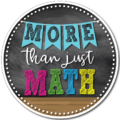Hey, just so you know… This post includes affiliate links. That means if you use them to make a purchase, I may earn a commission.

With the start of a new school year, I haven’t had much extra time to write a new blog, but this activity is TOO GOOD to not share!
As we were wrapping up our first chapter, I realized that I needed a new review activity to help students prepare for our test… and wow did Math Jenga absolutely deliver. There was 100% student engagement the entire Monday- yes Monday! I’m talking about students collaborating using mathematical language to solve problems and literally running to me with their answers due to pure excitement… Smiles, laughing, encouragement, teamwork and at the end of class, they asked when we could do it again! So here is everything you need to know (and do) to get this going in your classroom!
Shout Out to All the Teachers Who Share Their Great Ideas!
I saw this activity for the first time over the summer in one of my favorite math teacher Facebook groups. I immediately went to Pinterest to start researching directions and procedures to design a game that could be used for any unit in my classroom. In other words, I read that some people write questions directly on the blocks. This is such a great idea, but I wanted the game to be available no matter the content.
Everything You Need to Know About the Blocks

First, I started searching for colorful Jenga games. Amazon has some awesome, ready-to-go sets, but I wanted to have 7 games so that students could work in small groups around the room. (Here is an amazing set of a ready-to-go colorful Jenga set on Amazon, if you prefer this route.) However, since this would have cost me over $100, I continued looking.
A visit to the Dollar Tree was like winning the lottery. I purchased 7 Tumbling Tower Games for less than $10! The only problem was that these were not colorful, so I started experimenting.
After A LOT of trial and error, I discovered the most efficient method of dying the blocks was completed by using vinegar and food coloring. I used a 2-cup glass bowl just large enough to fit 2-3 blocks in the bottom at one time. I filled the bowl with enough vinegar to cover the blocks entirely when placed in the mixture. Then I added several squeezes of food coloring (not drops, squeezes). Since my food coloring set did not come with an orange, I used both yellow and a few drops of red to achieve orange.
**NOTE: WEAR GLOVES WHEN COLORING! (I may or may not have realized this the hard way.)
After putting on gloves, place 1-3 blocks into the mixture at a time. I rotated the blocks and then dipped the ends to ensure a complete coat on every surface. The blocks are only in the mixture for a few seconds. Then, I placed the blocks on a paper plate to dry.
After drying, I dipped the blocks a second time to create a more vibrant color. I had the most difficulty with purple, so I used more food coloring to produce a darker purple.
After all blocks were dry, I placed each set in a Ziploc bag and took them to my classroom. They did smell slightly like vinegar when first taken out of the bag, but that quickly disappeared.
Supply List
- Food Coloring
- 2 cup Glass Bowl
- Paper Plates
- Dollar Tree Tumbling Tower Games (72 piece)
- Rubber Gloves
- Color Dot Number Cubes- I purchased these.
Game Design
After researching several different ways to use this as a review game, I decided on the method below due to the following:
- Ability to use the game with a variety of content/subjects by adjusting the questions.
- Small group work to encourage collaboration, communication and teamwork.
- The main focus is on answering the question correctly, with the Jenga piece being an added bonus to increase motivation and engagement.
- Easy directions for students to follow.
How to Play
I put my class in teams of 2-3 students to play against another team of 2-3 students. I wanted them to collaborate and communicate the mathematical processes while they reviewed for the assessment. This size worked well. Each group needed 1 color block number cube, wooden blocks, and task cards. Each student had his/her own Answer Recording Sheet. Students worked their problems out on their desks with Expo markers or small white boards.

What You Need to do to Get Started!
- Buy Jenga/tumbling towers and dice.
- Color the blocks if they are not currently colored.
- Copy one answer recording document per student. Click on my free download below to save time creating one yourself!
- Create review questions for the cards. Each color has 12 blocks, so 12 questions per color are needed. I gave 3 freebies per color, which the kids loved.
- Print the questions on the colors listed on each sheet. (Use colored cardstock if possible.) Each group will need one set of the task cards.
- Cut the cards and place in Ziploc bags for easy distribution.
FREE Templates!

I love sharing the resources that I create for my classroom with other educators! To save you time in getting this ready to go for your classroom, here are my templates for FREE! Click here to get my Answer Recording Page, Editable Task Card Template, and Jenga Rules Poster!
P.S. Don’t forget to click the green star to follow my store while you are there so that you can receive updates on the new products that I add to my store!
Have Fun!
Megan



